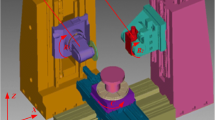Abstract
A force model is presented to theoretically predict single-tooth sawing force based on mechanics. The model is used to study the effect of the saw tooth profile parameters, such as rake and setting angles, on the sawing process so as to optimize the sawing process. Then, the force model is experimentally verified by a series of sawing force measurements. This study shows that the resultant force decreases with an increase in the rake/setting angle. Theoretically, there exists maximum rake/setting angle which, however, can never been reached in practice due to the process restrictions. Therefore, the optimal rake/setting angle is the maximum that can be obtained in the process. The study provides a theoretical foundation for design and optimization of the saw tooth profiles.
Similar content being viewed by others
References
Liu NH (2010) Study on bimetal hacksaw blades industry in China [J]. Technol Dev Enterp 23:125–127
Ko TJ, Kim HS (1999) Mechanistic cutting force model in band sawing [J]. Int J Mach Tools Manuf 39(8):1185–1197
Junz Wang JJ, Wu SH, Lee RS (2012) Chip fractal geometry and loading characteristics of sinusoidal multi-cutters in hack-sawing process [J]. Int J Mach Tools Manuf 59:65–80
Wu SH, Lee RS, Junz Wang JJ (2013) Specific energy distributions for sinusoidal multi-cutters in groove-sawing process [J]. J Mater Process Technol 213(5):641–659
Andersson C, Andersson MT, Ståhl JE (2001) Bandsawing. Part I: cutting force model including effects of positional errors, tool dynamics and wear [J]. Int J Mach Tools Manuf 41(2):227–236
Sarwar M, Persson M, Hellbergh H, Haider J (2009) Measurement of specific energy for evaluating the efficiency of bandsawing different workpiece material [J]. Int J Mach Tools Manuf 49(12-13):958–965
Li XH, Tang ZY, Chen TJ (1997) Force predition about band sawing [J]. Manuf Technol Mach Tool 03:29–31
Li HL, Jia CD (2003) A study on the cutting performance using bimental hacksaw blades for cutting 34Mn2V Alloy Structural Steel [J]. J Shen Yang Inst Technol 03:13–16
Lu B, Zhang SQ, Liang Y, Zhang XD (2000) A study on surface cracks of the bimetal strip saw blade [J]. Part: Phys Test 06:266–268
Lewis DB, Bradinabury SR, Sarwar M (1996) Effect of substrate surface preparation on the performance and life of TiN-coated high speed steel circular saw blades [J]. Surf Coat Technol 82(1-2):187–192
Chang WT, Chen LC. Design and experimental evaluation of a circulation saw blade with self-clamped cutting inserts [J]. International Journal of Advanced Manufacturing Technology, 2015(In press).
Chang WT, Su CH, Cuo DX, Tang GR, Shiou FJ (2013) Automated optical inspection for the runout tolerance of circle saw blades. Int J Adv Manuf Technol 66:565–582
Malkin S, Hwang TW (1996) Grinding mechanisms for ceramics [J]. CIRP Annals Manuf Technol 45(2):569–580
Yan L, Jiang F, Rong YM (2012) Grinding mechanism based on single grain cutting simulation [J]. J Mech Eng 48(11):172–182
Shang X, Zhou J, Zhou F, Luo Y (2015) Analysis of crack for complex structural parts and simulation optimization during hot forming [J]. Int J Adv Manuf Technol 80:373–382
Chen RY (2002) Theory of metal cutting [M]. China Machine Press, Beijing
Su SQ, Liu DD (2013) Mechanics of elasticity [M]. Wuhan University Press, Wuhan
Jiang F, Yan L, Rong YM (2013) Orthogonal cutting of hardened AISI D2 steel with TiAIN-coated inserts—simulation and experiments [J]. Int J Adv Manuf Technol 64:1555–1563
Chen MX (2007) Mechanics of elastoplasticity [M]. Science Press, Beijing
Author information
Authors and Affiliations
Corresponding author
Rights and permissions
About this article
Cite this article
Luo, Y., Ren, Y., Zhou, Z. et al. Prediction of single-tooth sawing force based on tooth profile parameters. Int J Adv Manuf Technol 86, 641–650 (2016). https://doi.org/10.1007/s00170-015-8201-0
Received:
Accepted:
Published:
Issue Date:
DOI: https://doi.org/10.1007/s00170-015-8201-0




